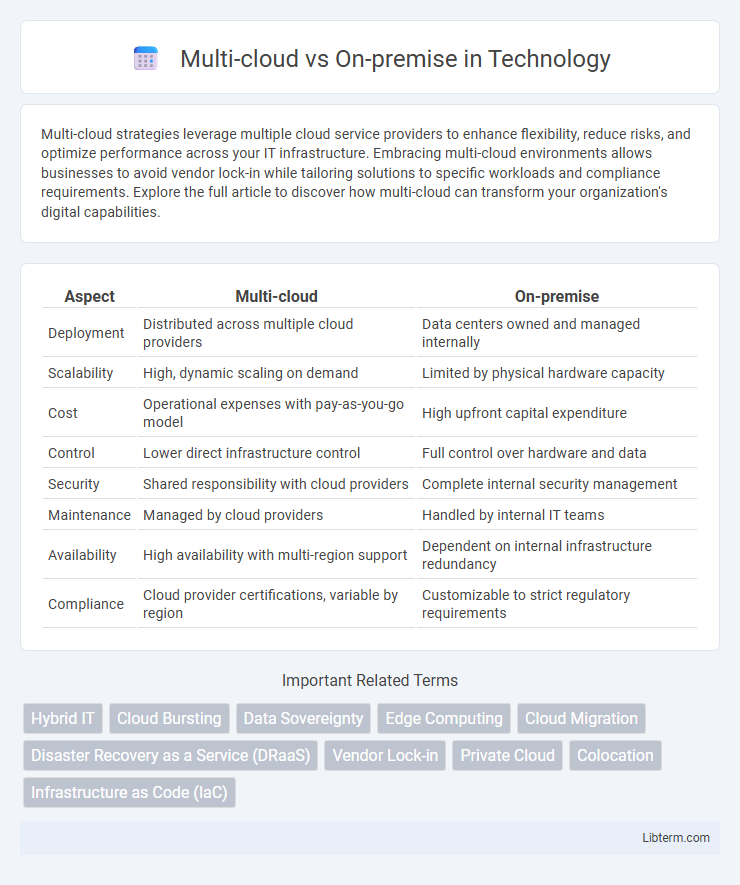Multi-cloud strategies leverage multiple cloud service providers to enhance flexibility, reduce risks, and optimize performance across your IT infrastructure. Embracing multi-cloud environments allows businesses to avoid vendor lock-in while tailoring solutions to specific workloads and compliance requirements. Explore the full article to discover how multi-cloud can transform your organization's digital capabilities.
Table of Comparison
| Aspect | Multi-cloud | On-premise |
|---|---|---|
| Deployment | Distributed across multiple cloud providers | Data centers owned and managed internally |
| Scalability | High, dynamic scaling on demand | Limited by physical hardware capacity |
| Cost | Operational expenses with pay-as-you-go model | High upfront capital expenditure |
| Control | Lower direct infrastructure control | Full control over hardware and data |
| Security | Shared responsibility with cloud providers | Complete internal security management |
| Maintenance | Managed by cloud providers | Handled by internal IT teams |
| Availability | High availability with multi-region support | Dependent on internal infrastructure redundancy |
| Compliance | Cloud provider certifications, variable by region | Customizable to strict regulatory requirements |
Introduction to Multi-cloud and On-premise Architectures
Multi-cloud architecture involves deploying applications and services across multiple cloud providers to enhance redundancy, flexibility, and avoid vendor lock-in, while on-premise architecture relies on localized hardware and infrastructure managed within an organization's physical facilities. Multi-cloud leverages public clouds like AWS, Azure, and Google Cloud, enabling scalable resources and global accessibility, whereas on-premise systems provide greater control, security, and compliance suited for sensitive data environments. Enterprise IT strategies often weigh the benefits of multi-cloud's agility against on-premise architecture's direct control to align with specific operational and regulatory requirements.
Key Differences Between Multi-cloud and On-premise Solutions
Multi-cloud solutions distribute workloads across multiple public cloud providers, enhancing redundancy, scalability, and flexibility, while on-premise solutions rely on localized data centers offering control, security, and compliance customization. Cost models differ significantly; multi-cloud often uses pay-as-you-go pricing reducing upfront capital expenditure, whereas on-premise demands substantial initial investment in hardware and maintenance. Data sovereignty and latency considerations favor on-premise systems for sensitive or localized data processing, whereas multi-cloud enables global accessibility and disaster recovery options.
Cost Considerations: Multi-cloud vs On-premise
Multi-cloud solutions often reduce capital expenditures by leveraging pay-as-you-go pricing models, minimizing upfront hardware investments compared to on-premise setups that require significant initial capital for servers and infrastructure. Operational expenses in multi-cloud environments can vary based on data transfer, storage, and compute usage, while on-premise solutions incur ongoing costs for maintenance, power, cooling, and IT personnel. Cost optimization in multi-cloud requires monitoring usage patterns and selecting appropriate service tiers, whereas on-premise demands precise capacity planning to avoid overprovisioning or performance bottlenecks.
Scalability and Flexibility in Deployment
Multi-cloud environments offer unmatched scalability, allowing businesses to quickly allocate resources across various cloud providers to meet fluctuating demands. On-premise solutions provide limited scalability constrained by physical hardware capacity, requiring significant time and capital investment to upgrade. Flexibility in deployment is enhanced in multi-cloud setups by enabling organizations to choose optimal platforms for specific workloads, whereas on-premise deployments often face rigidity due to fixed infrastructure configurations.
Data Security and Compliance Challenges
Multi-cloud environments enhance data security through diverse threat detection and distributed backups but complicate compliance due to inconsistent policies across platforms. On-premise solutions offer centralized control and compliance adherence, simplifying auditing and data sovereignty but face higher risks from physical breaches and require significant resource investment. Balancing multi-cloud flexibility with stringent regulatory requirements remains a critical challenge for enterprises managing sensitive data.
Performance and Reliability Factors
Multi-cloud environments enhance performance by distributing workloads across multiple providers, reducing latency and minimizing downtime through redundancy. On-premise solutions offer consistent reliability with dedicated infrastructure, enabling fine-tuned optimizations for specific applications and stable internal network conditions. Evaluating network bandwidth, failover capabilities, and resource scalability is crucial in choosing between multi-cloud agility and on-premise control.
Disaster Recovery and Business Continuity Strategies
Multi-cloud environments enhance disaster recovery by providing geographic redundancy and diverse infrastructure, reducing the risk of a single point of failure. On-premise disaster recovery relies on physical backup sites and hardware replication, often resulting in higher recovery time objectives (RTOs) and recovery point objectives (RPOs). Business continuity strategies in multi-cloud setups benefit from automated failover and real-time data synchronization, whereas on-premise solutions require substantial manual intervention and higher capital expenditure for resilience.
Integration and Interoperability Across Environments
Multi-cloud environments offer enhanced integration flexibility by enabling seamless interoperability among diverse cloud platforms, facilitating consistent data exchange and unified management across AWS, Azure, and Google Cloud. On-premise systems typically require customized middleware and APIs to bridge legacy infrastructure with modern applications, often leading to increased complexity and slower integration cycles. Leveraging containerization and API-driven architectures in multi-cloud setups accelerates cross-environment integration, reduces vendor lock-in, and improves scalability compared to traditional on-premise deployments.
Use Cases: When to Choose Multi-cloud or On-premise
Multi-cloud is ideal for organizations requiring scalability, disaster recovery, and global reach, such as e-commerce platforms, SaaS providers, and enterprises managing fluctuating workloads across regions. On-premise solutions suit industries with strict data sovereignty, compliance needs, or latency-sensitive applications, including healthcare, finance, and government sectors. Hybrid strategies often emerge when businesses need to balance regulatory control with cloud agility, leveraging on-premise for sensitive data and multi-cloud to optimize performance and cost.
Future Trends in Multi-cloud and On-premise Computing
Multi-cloud strategies are increasingly adopting advanced AI-driven orchestration and automation tools to optimize workload distribution, enhance security, and reduce latency across diverse cloud platforms. On-premise computing continues to evolve with edge computing integration and hybrid cloud models, enabling organizations to maintain control over sensitive data while leveraging cloud scalability and agility. Future trends indicate a growing convergence of multi-cloud and on-premise environments through unified management platforms and zero-trust security frameworks to address complex compliance and performance requirements.
Multi-cloud Infographic

 libterm.com
libterm.com